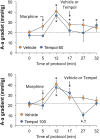Tempol Reverses the Negative Effects of Morphine on Arterial Blood-Gas Chemistry and Tissue Oxygen Saturation in Freely-Moving Rats
- PMID: 34630119
- PMCID: PMC8493249
- DOI: 10.3389/fphar.2021.749084
Tempol Reverses the Negative Effects of Morphine on Arterial Blood-Gas Chemistry and Tissue Oxygen Saturation in Freely-Moving Rats
Abstract
We have reported that pretreatment with the clinically approved superoxide dismutase mimetic, Tempol (4-hydroxy-2,2,6,6-tetramethylpiperidine-N-oxyl), blunts the cardiorespiratory depressant responses elicited by a subsequent injection of fentanyl, in halothane-anesthetized rats. The objective of the present study was to determine whether Tempol is able to reverse the effects of morphine on arterial blood-gas (ABG) chemistry in freely-moving Sprague Dawley rats. The intravenous injection of morphine (10 mg/kg) elicited substantial decreases in pH, pO2 and sO2 that were accompanied by substantial increases in pCO2 and Alveolar-arterial gradient, which results in diminished gas-exchange within the lungs. Intravenous injection of a 60 mg/kg dose of Tempol 15 min after the injection of morphine caused minor improvements in pO2 and pCO2 but not in other ABG parameters. In contrast, the 100 mg/kg dose of Tempol caused an immediate and sustained reversal of the negative effects of morphine on arterial blood pH, pCO2, pO2, sO2 and Alveolar-arterial gradient. In other rats, we used pulse oximetry to determine that the 100 mg/kg dose of Tempol, but not the 60 mg/kg dose elicited a rapid and sustained reversal of the negative effects of morphine (10 mg/kg, IV) on tissue O2 saturation (SpO2). The injection of morphine caused a relatively minor fall in mean arterial blood pressure that was somewhat exacerbated by Tempol. These findings demonstrate that Tempol can reverse the negative effects of morphine on ABG chemistry in freely-moving rats paving the way of structure-activity and mechanisms of action studies with the host of Tempol analogues that are commercially available.
Keywords: arterial blood pressure; blood-gas chemistry; morphine; rats; tempol; tissue oxygen saturation.
Copyright © 2021 Baby, Discala, Gruber, Getsy, Cheng, Damron and Lewis.
Conflict of interest statement
SB, JD, and RG were employed by Galleon Pharmaceuticals, Inc. The remaining authors declare that the research was conducted in the absence of any commercial or financial relationships that could be construed as a potential conflict of interest.
Figures





References
LinkOut - more resources
Full Text Sources

